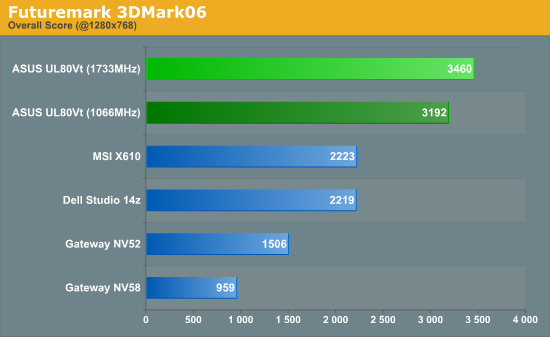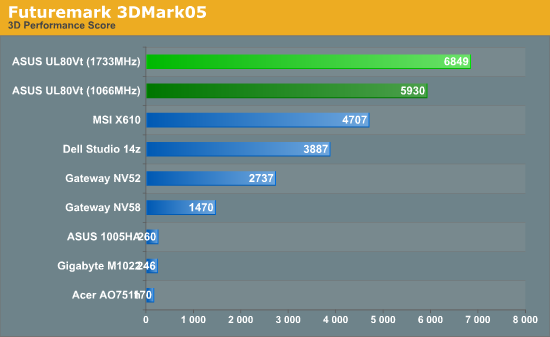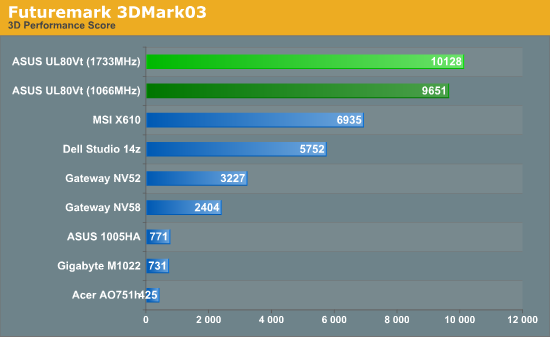ASUS UL80Vt First Look: Mobility Redefined
by Jarred Walton on October 24, 2009 8:00 PM EST- Posted in
- Laptops
ASUS UL80Vt Benchmarked - Graphics Performance
Our testing for now is confined to the use of the discrete GeForce G210M graphics on the UL80Vt. When we deliver our full review, we will include additional results using the integrated GMA 4500MHD. You can get a good idea of the 4500 MHD performance by looking at the Gateway NV58 results; the NV58 has a faster CPU, but for 3DMark and gaming performance the GPU is going to be a huge bottleneck.




Looking at 3DMark graphics performance, the G210M combined with the overclocked SU7300 delivers respectable performance. The G210M is clearly faster than the 9400M G integrated solution, with the advantage ranging from a low of 30% in 3DMark Vantage up to a high of 76% in 3DMark03. We realize 3DMark isn't true gaming performance, but most games correlate well with one of the versions. 3DMark06 and Vantage include CPU performance into the final score, which is why the gap between the 14z and UL80Vt isn't quite as large -- the P8600 should be at least 39% faster than the overclocked SU7300, and the detailed results confirm that. The CPU score in 3DMark06 is 1571 for the UL80 compared to 2117 with the 14z (a 35% advantage to the 14z), while the CPU score in Vantage is 3344 vs. 4284 for the 14z (28% faster). Meanwhile the 3D scores favor the UL80 by 58% in Vantage and 69% in 3DMark06. For reference, the Gateway NV52 with HD 3200 isn't even close in 3DMark; the UL80Vt is 130% to 214% faster!
Even at 1066MHz, the SU7300 with the G210M puts up a fight. The lead drops to 7.5% in Vantage (due primarily to the low CPU score), but it's still 44% in 06, 53% in 05, and 68% in 03. The comparison to the NV52 continues to be a landslide in favor of the SU7300+G210M: it's 105% faster in Vantage and up to 200% faster in 3DMark03.
We recognize that 3DMark isn't the be-all, end-all indicator of gaming performance, but as a quick test we can see that UL80Vt with the G210M enabled should never be slower than laptops with integrated graphics when it comes to gaming (i.e. the Dell 14z with 9400M G and the Gateway NV52 with HD 3200). It's also worth noting that the UL80Vt supports NVIDIA's reference drivers, just like other laptops with GeForce graphics (although you'll need to wait for updated drivers from NVIDIA if you want something newer than the 186.88 drivers the laptop ships with). At present, for graphics in notebooks the pecking order is roughly as follows:
- High-end and midrange discrete solutions (GeForce GTX 280M/260M and Mobility Radeon HD 4670 and 4870)
- Lower end discrete solution (Radeon HD 4330 and HD 3670, or GeForce 210M and 9600M, etc.)
- NVIDIA's current integrated graphics (GeForce 9400M G -- represented by the Dell Studio 14z).
- ATI's current integrated graphics (Radeon HD 3200 -- i.e. the Gateway NV52).
- Intel GMA 4500MHD and older NVIDIA/ATI IGP solutions (X1260 or GeForce 7000 or earlier).
- Intel's GMA 950 and earlier (typically seen in netbooks now).
The corollary to the above is pricing and power, and generally speaking the higher you go on the list, the more expensive the parts become and the worse battery life you get. That's the great benefit of designs like the UL80Vt: you can get reasonable graphics performance when you need/want it, but you can still switch off the graphics and run on the IGP for improved battery life. The G210M is designed to use a maximum of 8W, but when the rest of the laptop averages less than 10W of power, that's a potential 80% increase in power requirements. The slower IGP solutions -- especially from Intel -- do manage to keep power requirements low while offering dismal gaming performance. The HD 3200 and 9400M are much more palatable in terms of overall performance and video offloading features, with power requirements that are about the same as the GMA 4500.










100 Comments
View All Comments
ProDigit - Tuesday, October 27, 2009 - link
With the better graphics card I meant the integrated one.. Not the external one.Also, if I'd remove the external graphics card, would I have a PCIE slot available for mods?
ProDigit - Tuesday, October 27, 2009 - link
I don't agree on better LCD's on budget laptops!In fact I oppose it.
I'd rather pay $50 less for a laptop that has a worse LCD, than pay $50 more for a better LCD!
And by the looks of it, we're going that way, with PixelQi's screen which does not display colors faithfully, but could result in upto 20% more batterylife with their white background reflective screens.
I don't care about color precision. A netbook does not need a screen that is showing 32bits faithfully, or that has a high contrast ratio!
What it needs is show basic colors (16 - 24bits is more than ok!), and has a wide range of brightness.
If it isn't reflective (with white background like PixelQi's screens, or e-ink screens), then it needs to have an extreme low setting for comfortably using the PC in a dark room (eg bedroom at night without external light); and the info on the screen should be visible in the daylight, under the sun!
Contrast VS brightness, I'd set my $15 on better brightness settings,rather than pay $50 for a higher quality screen.
Faithful reproduction of screen colors only matter for those who need it, like web designers, photographers, video editors...
But the majority of users are like me. 99% does not care if the green looks a bit blue-ish, or the white looks somewhat a bit yellowish!
strikeback03 - Tuesday, October 27, 2009 - link
But if the screen crushes blacks so badly that all the pics from last Saturdays party that you are looking at on Facebook look like shadows in a coal mine, that screen has failed at even basic functions.Again, I don't think anyone is asking for better screens to be standard, but make them an option in models which are otherwise nice for those who are willing to pay for the upgrade.
atlr - Monday, October 26, 2009 - link
I would pay more for a better display with a matte or antiglare finish.Exile550 - Tuesday, October 27, 2009 - link
I would like very much a matte finish.estyx - Monday, October 26, 2009 - link
Can you please test it when using the GPU for HD-resolution decoding? I.e MPC-HD playing 720p and 1080p h264 with gpu-accel decoding. This is very useful to know when concidering buying a laptop for taking long trips on train, bus, car etc, because then you're so bored you need some movies and series to watch :)Otherwise it seems like a nice laptop! Looking forward for a bit deeper review
JarredWalton - Monday, October 26, 2009 - link
I'm running all sorts of tests as I get the chance. The GMA 4500MHD does x264 offload, as does the G210M. I can tell you that my test x264 720p file just about 6:30 with the 4500MHD; the G210M test is still running. I have a bunch of tests to still run (with and without Turbo, IGP and discrete, gaming performance, etc.) but that will all be revealed eventually. Given the number of tests I still need to run, I expect it to be another week or two before I'm anywhere close to finished.robertpolson - Monday, October 26, 2009 - link
I am dealing with a dilema righ now. Stay with my order for UL80vt, get a macbook pro or wait for UL30vt to come out (if it will) at the end of the year.What I like about UL over macbook pro:
1) Longer battery life
2) More hard drive space
3) Double the memory
What I do not like about UL comparing to macbook pro:
1) No bluetooth
2) Webcam sucks big time - 0.3 megapixel is a joke in 2009
3) Larger in size comapring to macbook pro.
I think I ca live with either OSX and Windows 7.
What do you think ?
JarredWalton - Monday, October 26, 2009 - link
What do you use Bluetooth for? The only time I've ever used it on a laptop was for a Bluetooth mouse, but I'd definitely prefer a wired mouse; the BT mouse was a bit finicky.As for the webcam, I'm not sure if it matters that it's "only" 0.3MP. All the video conferencing stuff I've tried seems to limit me to 320x240 video regardless. I certainly don't take pictures with my laptop webcam; do you?
Mind you, I'm not saying these areas aren't important. You say they are for you, so I'm just wondering what it is you do that I may have overlooked, since I've never felt either was necessary.
PS - Benefit #4: optical drive, if you need it.
heulenwolf - Monday, October 26, 2009 - link
Dear Asus,I've been tracking netbooks since you released the first EEEPC. I always found them interesting but, despite their low price, continued to buy larger laptops or smaller internet-enabled devices until the 1005HAB came out. I saw it while perusing a Best Buy and could not resist. The screen is so nice to look at that it makes me look past some of the drawbacks inherent in a netbook. When at home, I'll gladly use the $300 netbook instead of my $2000 work laptop with a larger screen, faster and better everything (except for the screen, though its no slouch), and longer battery life. When I'm traveling, I don't even consider other options. I bring the 1005HAB. If you'd like this happy Asus EEEPC customer to purchase more lucrative Asus products in the future, please give more weight to the screen quality in your value proposition than was demonstrated in this review.